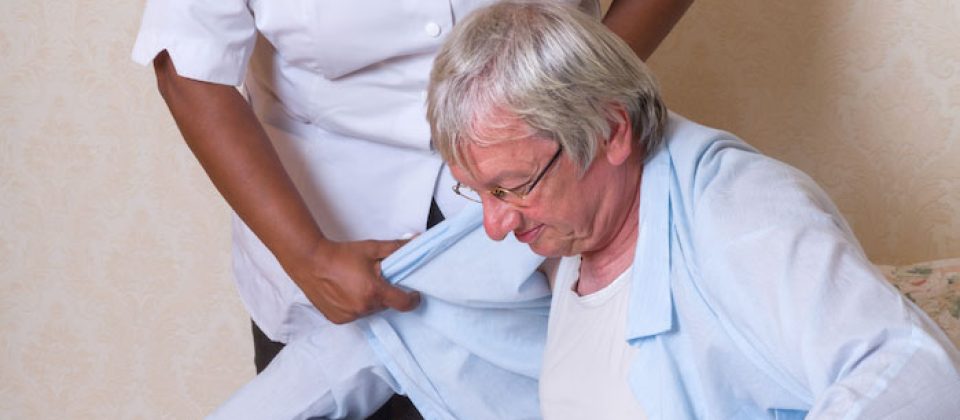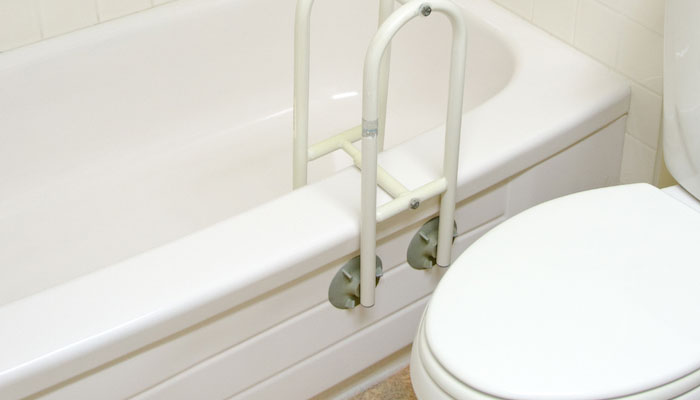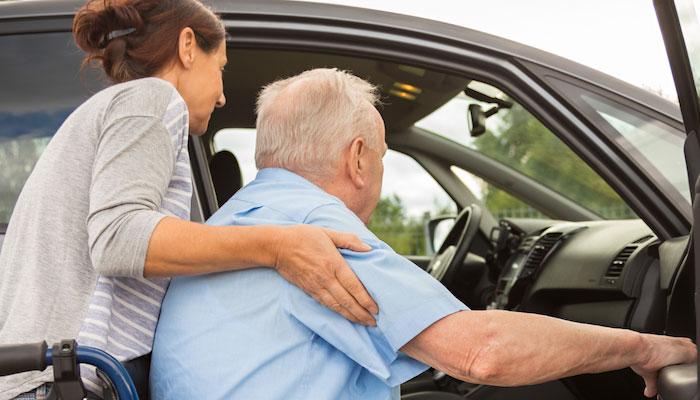
Dressing with Alzheimer’s Disease
In helping a person with Alzheimer’s disease (AD) to select and put on clothing, be mindful of the choices he used to make, and try to honor that taste and style. For example, if an elderly man had worn a tie every day to work but could no longer tie the knot and was frustrated if he could not put the tie on every day, a simple solution is to tie several in advance for him and let him slip the ties on and off. That may be easier for him to do and save you time. Sometimes a “clip-on” tie will work also.
Most people have favorite colors, textures, and types of clothing—and people with dementia often want to wear the same outfit all the time. If you get duplicates of the items the person always wants to wear, he can still be comfortable when clothes are being washed and you will avoid arguments and explanations. Clean out closets and drawers so that out-of-season or difficult-to-clean clothes will not be temptingly in view. If the person wants to wear something you don’t like, try to accept his choice, unless it is totally inappropriate.
Lay out clothing in the order in which it should be put on. This will provide a cue to those who are unsure what to put on next, and will generally make the process run more smoothly when you have to assist. You will also not need to leave the person to go find a missing piece.
Use clothes that are easy to put on.
- Store all like clothes together.
- Use shoes that slip on or fasten with Velcro®.
- Use socks rather than pantyhose.
- Use pants and skirts with elastic waistbands.
- Use bras with front openers.
- Avoid clothes that have to be put on over the head.
- Replace buttons with Velcro® closures.
Sometimes, people with Alzheimer’s disease will undress at inappropriate times. If it is because he is fidgeting and unintentionally opening buttons, consider sweaters without buttons, or a one-piece jump suit. Sometimes, wearing an apron will be a distraction. If things are sewn onto the apron, that will give the person something to touch and feel with his hands, distracting him from trying to remove a shirt or pants.
It may be best to have a frail person or someone with poor balance or a disability sit down when you help dress him, unless of course he is bed bound. If the person has a “weak” side, dress it first. For a person who is confined to bed, be sure to smooth out all wrinkles in the clothes and bedding to prevent pressure sores.

Bathing
Bathing is often called the most challenging activity for both the person with dementia and the caregiver. What a shame that the idea of relaxing in a warm tub filled with bubbles rarely matches the typical caregiver–care receiver experience. Standing naked, afraid of falling, in a room that may be drafty, with water coming from all kinds of unexpected places may result in pain, fatigue, weakness, confusion, and anxiety for the person with Alzheimer’s disease. These feelings may also exist before the bath and get worse because of the bath. If “bath” is a bad word, try saying, “Let’s get ready for the day (or night as the case may be).”
To make bathing easier—
- Let the person feel in control. Does the person prefer showers, a tub bath, and at what time of day?
- Create a safe atmosphere. Put non-slip adhesives on the floor and bottom of tub, install grab bars to prevent falls, test the water temperature in advance.
- Use a bath bench.
- Respect the person’s dignity. Allow the person to keep a towel around him or her both in and out of the shower, if necessary.
- Don’t worry about daily bathing. It doesn’t have to be done every day. Sponge baths can be used in between showers and baths.
- Be gentle. The person’s skin may be sensitive. Avoid scrubbing. Pat dry, then use lotion.
- Be flexible. If the person does not want a shampoo, use a wash cloth to soap and rinse the hair or a shampoo in a cap. A no-rinse shampoo can be substituted for a regular shampoo.
Talk with the person, tell him what you are going to do next, encourage him to wash areas that he can and watch that the flow of water is not too strong. These tips can contribute to making bathing a pleasant experience.
A person can also be washed in his room in bed, if showers or baths are not comfortable or feasible.

Taking Care of Yourself— Dependency and Isolation
Fears of dependency and loneliness, or isolation, are common in families of those who are ill. The person needing care can become more and more dependent on the one who is providing it. At the same time, the caregiver needs others for respite and support. Many caregivers are ashamed about needing help, so they don’t ask for it. Those caregivers who are able to develop personal and social support have a greater sense of well-being. Note, spouse caregivers have special problems as they gradually lose the emotional support of the partner who is ill and must now be his or her emotional as well as physical support. It is especially important for spouse caregivers to seek out a support system.
Source: The Comfort of Home for Alzheimer’s Disease: A Guide for Caregivers
Memory Care – Poor Vision
Don’t assume that the reason the person in your care doesn’t recognize others is due to AD without having his vision checked. If the person in your care does not see well, perhaps new glasses will help. In any case, rather than risking startling the person, it is best to say who you are as you approach.

Safety Tips – Early Stage Decisions
In the early stage of Alzheimer’s it is common for caregivers to wonder how much the person can still do on his own, and when they should step in and be protective. These are some of the questions to ask yourself. Is it safe for the person to—
- continue driving?
- continue to work?
- take medications on his own?
- travel on his own?
- make financial decisions that he has been making until now?
You will continually have to evaluate the benefits and risks. He may very much want to continue to drive, but if he has an accident because he cannot drive safely, someone may get hurt or killed. However, if the person wants to dress himself and cannot select matching clothes, there is no risk, and a lot to gain by letting him dress himself.